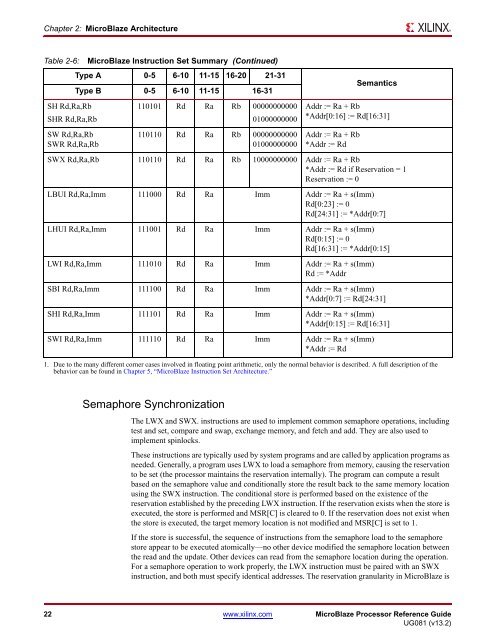MicroBlaze Processor Reference Guide (UG081) - Xilinx
MicroBlaze Processor Reference Guide (UG081) - Xilinx
MicroBlaze Processor Reference Guide (UG081) - Xilinx
You also want an ePaper? Increase the reach of your titles
YUMPU automatically turns print PDFs into web optimized ePapers that Google loves.
Chapter 2: <strong>MicroBlaze</strong> Architecture<br />
Table 2-6: <strong>MicroBlaze</strong> Instruction Set Summary (Continued)<br />
SH Rd,Ra,Rb<br />
SHR Rd,Ra,Rb<br />
SW Rd,Ra,Rb<br />
SWR Rd,Ra,Rb<br />
Type A 0-5 6-10 11-15 16-20 21-31<br />
Type B 0-5 6-10 11-15 16-31<br />
110101 Rd Ra Rb 00000000000<br />
01000000000<br />
110110 Rd Ra Rb 00000000000<br />
01000000000<br />
Semaphore Synchronization<br />
Addr := Ra + Rb<br />
*Addr[0:16] := Rd[16:31]<br />
Addr := Ra + Rb<br />
*Addr := Rd<br />
SWX Rd,Ra,Rb 110110 Rd Ra Rb 10000000000 Addr := Ra + Rb<br />
*Addr := Rd if Reservation = 1<br />
Reservation := 0<br />
LBUI Rd,Ra,Imm 111000 Rd Ra Imm Addr := Ra + s(Imm)<br />
Rd[0:23] := 0<br />
Rd[24:31] := *Addr[0:7]<br />
LHUI Rd,Ra,Imm 111001 Rd Ra Imm Addr := Ra + s(Imm)<br />
Rd[0:15] := 0<br />
Rd[16:31] := *Addr[0:15]<br />
LWI Rd,Ra,Imm 111010 Rd Ra Imm Addr := Ra + s(Imm)<br />
Rd := *Addr<br />
SBI Rd,Ra,Imm 111100 Rd Ra Imm Addr := Ra + s(Imm)<br />
*Addr[0:7] := Rd[24:31]<br />
SHI Rd,Ra,Imm 111101 Rd Ra Imm Addr := Ra + s(Imm)<br />
*Addr[0:15] := Rd[16:31]<br />
SWI Rd,Ra,Imm 111110 Rd Ra Imm Addr := Ra + s(Imm)<br />
*Addr := Rd<br />
Semantics<br />
1. Due to the many different corner cases involved in floating point arithmetic, only the normal behavior is described. A full description of the<br />
behavior can be found in Chapter 5, “<strong>MicroBlaze</strong> Instruction Set Architecture.”<br />
The LWX and SWX. instructions are used to implement common semaphore operations, including<br />
test and set, compare and swap, exchange memory, and fetch and add. They are also used to<br />
implement spinlocks.<br />
These instructions are typically used by system programs and are called by application programs as<br />
needed. Generally, a program uses LWX to load a semaphore from memory, causing the reservation<br />
to be set (the processor maintains the reservation internally). The program can compute a result<br />
based on the semaphore value and conditionally store the result back to the same memory location<br />
using the SWX instruction. The conditional store is performed based on the existence of the<br />
reservation established by the preceding LWX instruction. If the reservation exists when the store is<br />
executed, the store is performed and MSR[C] is cleared to 0. If the reservation does not exist when<br />
the store is executed, the target memory location is not modified and MSR[C] is set to 1.<br />
If the store is successful, the sequence of instructions from the semaphore load to the semaphore<br />
store appear to be executed atomically—no other device modified the semaphore location between<br />
the read and the update. Other devices can read from the semaphore location during the operation.<br />
For a semaphore operation to work properly, the LWX instruction must be paired with an SWX<br />
instruction, and both must specify identical addresses. The reservation granularity in <strong>MicroBlaze</strong> is<br />
22 www.xilinx.com <strong>MicroBlaze</strong> <strong>Processor</strong> <strong>Reference</strong> <strong>Guide</strong><br />
<strong>UG081</strong> (v13.2)












